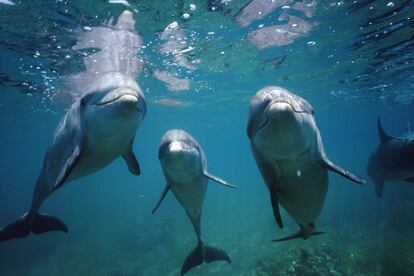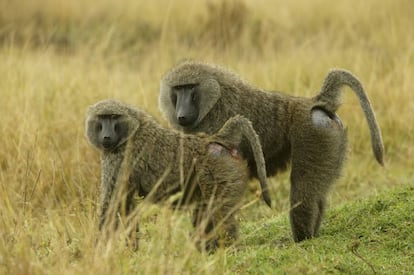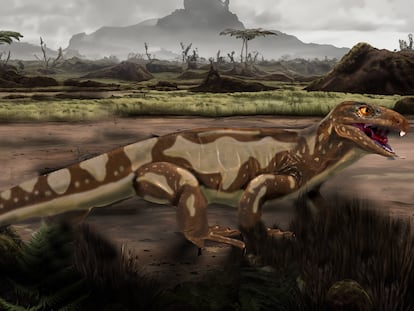The taboo of animal friendship, an evolutionary advantage not exclusive to humans
The scientific community has moved away from its historical reluctance to use the term friendship to refer to close relationships between animals

Hare and Ellington were two old males living in Kibale National Park in Uganda. They were not related, but they made a good team. After a hunt, Ellington would extend an arm, a common gesture for chimpanzees to ask for food, and Hare would give him a piece of his meat. They spent days moving through the forest together and, when separated, maintained contact through loud vocalizations. When Ellington died, Hare changed suddenly and isolated himself away from the group for weeks, as if he needed to mourn.
A few years later, on the other side of the world in Sarasota Bay, Florida, dolphins also showed their affinity for each other. A 58-year-old female named Nicklo used to hunt near the shore, in a shallow area where schools of fish abound. One day, she was accompanied by another old female to whom she was not related. Between the two of them, they grouped the fish and stunned them with their tails to eat them. This caught the researchers’ attention, as they rarely saw female dolphins hunting together. However, for Nicklo and her partner this became routine. They might simply have a working relationship, but they were often seen swimming together in other areas, as if they were simply out for a stroll.
Charismatic animals like dolphins and chimpanzees offer anecdotes about friendship that move us and become popular. However, these species were not the ones that made the scientific community decide to use the label “friendship” in studies on animal social relationships.
Scientists must be very careful with the terms they use to avoid misunderstandings. When describing a new behavior, several names often emerge until a consensus is reached. For example, primates love newborns. They have a very common behavior of approaching babies to sniff and paw them, sometimes even snatching them from their mother’s arms. When this was first referred to in scientific studies, labels such as aunting and kidnapping were used. The former had positive connotations and the latter negative ones, so it ended up being called infant handling.
At first, no academic dared to use the word friendship in their studies on animals. They observed that individuals had marked preferences when it came to relating to each other, but they spoke of close bonds or relationships. Friendship was only referred to in relaxed gatherings. If this word was included in a scientific article, it was put in italics, as if this protected the author(s) from accusations of anthropomorphism or a lack of rigor. Poking fun at themselves, some scientists used to refer to friendship as the F-word, referring to the fact that this term was unmentionable.
In the early 1980s, the idea that human relationships were very different from those of animals was well established. Humans formed unconditional friendships, in which we gave something for nothing, while animals were like economic machines. They were not driven by feelings of affection, but by “I am helping you today, because you will help me tomorrow” or “I am joining you for convenience.” Therefore, their relationships were not worthy of being called friendship.

In 1985, American anthropologist Barbara Smuts brought animal friendship out into the open with her book Sex and Friendship in Baboons. The first studies on the social behavior of baboons had begun in Kenya in the 1970s. By measuring the time these monkeys spent in close proximity and grooming each other, they discovered that baboons formed very close relationships with some females and not others. They were often related, but not always.
The data made it clear that baboons had a very complex social world. I was able to see this firsthand when I was working in Senegal, following a group of Guinean baboons. This species has a different social life than the baboons found in Kenya, as males are the ones that establish strong long-term relationships.
I remember once I was following a young buck named Bela, while taking data with a smartphone. I was so intent on my cell phone that I missed a branch and tripped. I didn’t hit the ground, but I made a sudden movement that startled Bela, causing him to scream very loudly. Five seconds later, I was surrounded by his best friends, three huge baboons that started screaming and raising their eyebrows threateningly. They made it very clear to me: if I intended to harm Bela, I would have to deal with them first.
These days, animal friendship appears frequently in scientific articles. The wide acceptance of the term stems from the fact that evidence indicates that the relationships of humans and other primates are quite similar. Like us, they too have friends.
It is important to emphasize that friendship is an adaptation. That is, it is widespread because it confers survival and reproductive advantages. For example, a 1993 study showed that lower-class humans gave birth to heavier babies when they had strong social connections. Similarly, better-integrated baboons are also more successful in raising their young.
Friends and evolutionary adaptation
It is in everyone’s best interest to have friends. However, when two children become friends, they do not think that this improves their chances of reproduction and survival. It is the same with other animals: their friendships have an adaptive function, but that does not necessarily mean that their actions are not driven by emotions similar to ours.
In fact, monkeys seem to be quite bad at keeping track of favors. Some authors have proposed that reciprocity in animal relationships is unconditional in the short term and based on emotions. These ideas are supported by studies indicating that a primate is more likely to help another primate if it has a long-term close relationship with it than if the primate has helped it recently.
At the physiological level, we know that the mechanisms that mediate the relationships of humans and other animals are very similar. Oxytocin and vasopressin govern social bonding. A 2007 study showed that the septal area of the human brain, which controls the release of oxytocin and vasopressin, is involved in our unconditional trust in our friends. Interestingly, this area is highly conserved in form and function in a variety of species.
This is not to say that animals experience their friendships in the same exact way we do. Humans have highly developed social capabilities that allow us to deeply understand the perspective, knowledge and feelings of other individuals. Each species has its own unique way of relating. By using the term friendship for animals, we are not denying this diversity, but once again accepting that we are not so different.
Sign up for our weekly newsletter to get more English-language news coverage from EL PAÍS USA Edition
Tu suscripción se está usando en otro dispositivo
¿Quieres añadir otro usuario a tu suscripción?
Si continúas leyendo en este dispositivo, no se podrá leer en el otro.
FlechaTu suscripción se está usando en otro dispositivo y solo puedes acceder a EL PAÍS desde un dispositivo a la vez.
Si quieres compartir tu cuenta, cambia tu suscripción a la modalidad Premium, así podrás añadir otro usuario. Cada uno accederá con su propia cuenta de email, lo que os permitirá personalizar vuestra experiencia en EL PAÍS.
¿Tienes una suscripción de empresa? Accede aquí para contratar más cuentas.
En el caso de no saber quién está usando tu cuenta, te recomendamos cambiar tu contraseña aquí.
Si decides continuar compartiendo tu cuenta, este mensaje se mostrará en tu dispositivo y en el de la otra persona que está usando tu cuenta de forma indefinida, afectando a tu experiencia de lectura. Puedes consultar aquí los términos y condiciones de la suscripción digital.
More information
Últimas noticias
Welcome to the post-religion era: The idea of Christianity as the absolute truth has become obsolete
‘I thought you would like it’: The risky sexual practice popularized by TV shows and TikTok
The digitalization of tourism: ‘They promise experiences and gave us the worst possible one’
Mexican peso defies uncertainty with forecasts of a new period of stability in 2026
Most viewed
- Sinaloa Cartel war is taking its toll on Los Chapitos
- Reinhard Genzel, Nobel laureate in physics: ‘One-minute videos will never give you the truth’
- Oona Chaplin: ‘I told James Cameron that I was living in a treehouse and starting a permaculture project with a friend’
- Why the price of coffee has skyrocketed: from Brazilian plantations to specialty coffee houses
- Silver prices are going crazy: This is what’s fueling the rally











































